Posts Tagged ‘MF’
 Upcoming Solar Years … Can They Be Too Quiet?
Upcoming Solar Years … Can They Be Too Quiet?

Most of us LF/MF and topband diehards have been looking forward to the next several years of low solar activity ... maybe even 'ultra-low' as some of the solar gurus are predicting.
An interesting posting on the Topband reflector a few weeks ago by noted propagation expert, Carl, K9LA, made me re-think my expectations!
I flagged the post for a later blog topic but have since seen the information pop-up on a couple of other reflectors as well as on the ARRL News page. Apparently I wasn't the only one to give the posting a double-take. If you missed it, here is Carl's post:
About a week ago Wolf DF2PY posted a message here commenting on the recent adverse levels of geomagnetic field activity and how it will now change for the good - giving us good 160m propagation.
We'll certainly see less geomagnetic field activity as we move into winter,
but there's another issue we should be aware of. The Sun's magnetic field
is weakening - probably to the lowest levels in our lifetime. With a weak
solar magnetic field, more galactic cosmic rays will be able to get into
the Earth's atmosphere. We are now seeing unprecedented high neutron counts (neutrons are one of the by-products of cosmic rays)
Since galactic cosmic rays are mostly *very energetic* protons, they can
get down to low atmospheric altitudes, causing collisional ionization in
the D region (and lower E region). A cursory estimate using cosmic ray
ionization rates confirms more ionization in the lower atmosphere. 160m is
not very tolerant of more absorption, so we may see an adverse effect of
the weakened solar magnetic field.
Many of us think that "solar min is solar min is solar min". But maybe a
solar minimum can be too deep for 160m. A good question to ask in the early 2020s will be "how was 160m?" So stay active on 160m and let's see what happens.
Carl K9LA
My initial response was to think that perhaps there wouldn't be as much to look forward to as I had been hoping for, when it came to improved LF, MF and 160m propagation. Carl's postulation was also backed-up by another mention on the Spaceweather site, although the influence of cosmic ray bombardment on radio propagation was not discussed.
As I thought more about this unfortunate possibility actually coming to pass, I thought back to my own on-air and listening experiences during previous solar-low years ... particularly the unprecedented low between our most recent cycle and its predecessor, Cycle 23.
The low period between these two cycles, as most will likely recall, saw the quietest solar conditions observed in the past 100 years. The solar-low winters saw week after week of a blank Sun, with solar activity virtually flatlining for the entire period. In 2008 there were 265 'zero sunspot' days and the following year saw another 262 days of blank suns!
These effects were well noted here for two winters that are usually prime 'DX times' ... if ever there were a period when cosmic ray bombardment should negatively impact low frequency propagation, surely it would have been then.
So just what did I observe?
What I saw was not only what I had been expecting but was much much better than I had ever believed possible. For west coast topband operators, the 'holy grail' of propagation is working Europe. Working Europe from here means that signals must travel through the polar regions, usually the kiss-of- death for weak signals, as the severe attenuation through the auroral zone means that it just doesn't happen very often ... except for this prolonged period of ultra lows. In a word, conditions to Europe were 'spectacular' ... night-after-night, for several weeks over a period of two winters, working Europe on 160 became normal.
On most nights, European signals could be heard before local sunset, and on several occasions, CW contacts with Europeans, were completed up to one and a half hours before my local sunset. As darkness set in, more signals would appear and the band would rapidly become populated with Europeans ... and only Europeans.
Most of the time there were no signals from North America evident, just Europeans ... a condition that had me shaking my head in disbelief night after night. It was something I had never observed before, as I watched 160m behaving more like 20m CW on a good day to Europe! During this period, my DXCC totals skyrocketed from 99 to 143 worked, as new Europeans and Africans were added to my logbook.
Signal levels were also outstanding, often pushing the FT-1000 S-meter well past the S9 level. On one particular night, I recall hearing an SM4 calling CQ, with just such a signal. I set my output power level at 10 watts and gave him a call, to which he quickly responded. If cosmic ray bombardment was at a high level, it was not reeking any havoc as far as the west coast path to Europe was concerned! For the record, my topband system is nothing special, consisting of a simple 'half-sloper' over a poor ground and a very old amplifier running about 500W output.
My other favorite winter pastime is chasing NDBs in the MF range between 200-500 kHz. Exceptional east west conditions were evident throughout the two winters of ultra-lows.
On one such night, I noted a new strong signal where none had been previously heard. Because of its strength, I surmised that it was probably a new NDB in nearby Washington state. Noting its ident ('NYA' on 414 kHz), I was not able to find any reference to such a beacon being previously reported and turned to the Yahoo ndblist group for help, posting my catch as 'unidentified'. Almost immediately I received a response, telling me that the signal I was hearing was located in Europe ... Svalbard to be exact, located midway between Norway and the North Pole!
Now, European NDBs have never been heard from the west coast, other than occasional signals from some of Greenland's powerhouses, so this represents a very rare event. Although I have often listened for this signal, it has yet to be heard here again and my logging of remains its only reported foray into any part of North America. Unfortunately, in 2015, it was listed as 'decomissioned'. I have no doubts that this rare propagation was a result of the solar flatlining conditions of the time.
As chilling as Carl's warning sounds, he himself admits uncertainty with a 'let's wait and see' attitude and after reviewing my own experiences under what surely must be similar conditions, I'm still very optimistic over what might be in store. Hopefully we shouldn't have to wait too much longer to find out!
 More On The PAØRDT E-Probe
More On The PAØRDT E-Probe
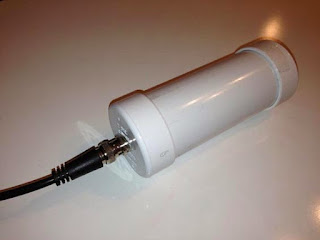 |
| Courtesy: http://www.leeszuba.com/projects/ |
Another recent reflector question about noise mitigation for active e-probe antennas brought further incite from Roelof Bakker, PAØRDT.
I found particular interest in his method of determining if the noise is being picked up by the antenna or being introduced by the feedline. As well, Roelof suggests one of the most important aspects of homebrewing ... keeping detailed notes of all tests or changes. He also suggests maintaining a healthy outlook regarding noise and rather than getting discouraged, take on the challenge of overcoming it!
Hello all,
I have been dealing with this subject for more then 10 years now and
I am pleased to pass on what I did learn so far.
The first item to look at is noise pick up on the feed line. This
can be a coax cable or a CAT5/6/7 network cable. Looking for noise
pick up on the feed line should be done without the active antenna
connected. Otherwise everything should be the same as when using the
antenna.
Ideally the antenna should be replaced by a 50 ohm termination that
can handle the power that is supplied by the DC-power supply feeding
the antenna. However, this is not necessary to achieve good results.
I am fortunate to own a PERSEUS SDR, that besides an excellent
receiver is also a nice piece of test gear. For noise pick-up
measurements I use HF-Span that changes the PERSEUS into a 0-40 MHz
spectrum analyser with a noise floor of -112 dBm. For narrow band
measurements the PERSEUS is used with Linrad, which can provide
accurate results.
Whilst looking at noise pick-up on the cable, one can unplug all
suspect devices and check if the noise is still present.
The most effective measure is grounding the shield of the coax cable
at the bottom of the mast, but I had still noise ingress of about -
100 dBm around 15 MHz. This could be solved by moving the power
supply and interface of the antenna from the operating position to
the location of the cable entry to the house. This minimises the
length of cable inside the house before the a rf-isolating
transformer used in the interface.
It is mandatory to use a separate radio earth, isolated from the
mains earth. My PC is connected to a mains outlet with a mains earth
connection, but no other equipment in the shack is using the mains
earth. This works for me.
There is also a discussion about the use of a common mode choke
versus a rf-isolating transformer. I have tried both and they both
work. However a rf-isolating transformer is much easier (and
cheaper) to build than common mode chokes with a winding of coax
cable.
In this regard, I should mention a source of interference that is
easily overlooked: receivers. It is not uncommon to own more than
one receiver and it appears that the antenna port is often far from
clean. I am using four SDR's which are fed from a balanced Norton
amplifier / four port splitter and these produce noticeable noise.
Using four rf-isolating transformers at the outputs of the splitter
eliminated the noise. My mini-whip is feeding up to 8 receivers
(hardware) via amplifiers /splitters / rf-isolating transformers
without degrading the receiver noise floor by mutual noise ingress.
The last point is about masts. A metal mast will decrease the signal
level when the antenna is mounted close to it. A short PVC extension
mast will help. The reason I am using a non-conductive mast is a
practical one as cheap and sturdy stackable camouflage net mast
sections were and are still available in western Europe. These are
ideal for either testing antennas and for permanent installations.
Metal masts can introduce problems by being resonant at a certain
frequency and receiving noise that can be transferred to the feed
line. However, checking the feed-line as described above will make
clear if this is the case or not. If there are no problems, there is
nothing against the use of a metal mast.
As every location is different, it is no use to provide an exact
recipe to solve noise problems. I believe that a systematic approach
is mandatory; take notes etc. as it is too easy to run in circles.
By all means do measure what you are doing, otherwise you will walk
in the dark for sure.
The good news is that it is still possible to build a low noise
reception system in the city and doing so can be fun! What might
also help is to change the attitude from 'it should not be there
after all' to 'what can I do about it!'
Best regards and 73,
Roelof Bakker, pa0rdt
If you're thinking about having a listen on LF or on 630m, the e-probe antenna can be a very effective solution .... and it takes up very little space. The finer details regarding the PAØRDT active antenna may be found here and here. All previous blog postings related to this topic may be found here.
 Saturday’s 630m Crossband Night – Reminder
Saturday’s 630m Crossband Night – Reminder
This is a reminder of tomorrow's '630m activity night'. Highlights of the evening will see six different Canadian stations seeking contacts with other amateurs in North America via the 'crossband mode' as they call CQ on 630m CW but listen for replies on their announced (QSX) HF frequency. As well, there will be an increased level of on-air activity from many of the U.S. experimental stations, as they beacon or work each other on various modes including CW and JT9, the WSPR QSO-mode. The experimental stations are also seeking your reception reports.
More information may be found here regarding the activity night, including a detailed list of participating Canadians along with their respective transmitting and QSX HF listening frequencies.
As is often the case, old 'Sol is threatening to throw some junk our way over the next day or two, right on time for our event but please don't let that stop you from participating as often this can actually enhance propagation, especially on the north-south path.
We hope to see many of you tomorrow night!
 CLE 212 Results
CLE 212 Results
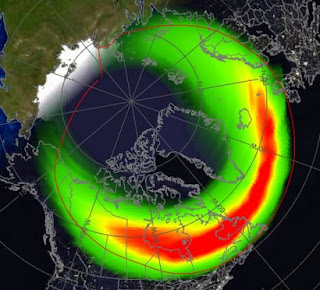 |
| Friday's auroral condx courtesy of :OVATION |
Well another CLE has come to pass with most listeners in North America reporting poor conditions ... other than those in the southern states.
As typically happens when hit with a serious geomagnetic event (why do they always coincide with our CLE's?), northernmost stations are affected worse than those further south. This disturbance was a strong and persistent solar wind, making the band very noisy. Signals in the Perseus SDR waterfall that looked as if they should be easy copy, were mushy and run together, making many idents uncopyable in the solar wind noise.
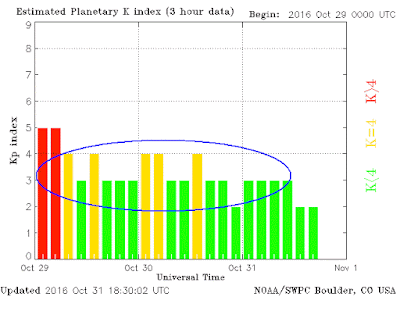 |
| Welcome to CLE 212 couretsy of: OVATION |
The east-west path, being reliant on quiet geomagnetic conditions, was totally absent, with no NDB's from Ontario making it into my log. Somewhat surprising was the rarely heard Galapagos Island NDB on 272 kHz ... heard widely throughout North American.
 |
| GLS - 272 Galapagos courtesy: Google Maps |
As usual, my receiver for the CLE was the Perseus SDR along with my normal LF / MF inverted-L antenna, tuned to ~ 300kHz.
29 08:00 272.0 YLB Lac La Biche, AB, CAN
29 11:00 272.0 XS Prince George, BC, CAN
30 06:30 272.0 GLS Galapagos, GAL
29 05:00 274.0 FR Fort Resolution, NT, CAN
29 08:00 275.0 SF Williston, ND, USA
29 07:00 275.0 HIN Chadron,NE, USA
29 05:00 275.0 GEY Greybull, WY, USA
29 06:00 275.0 AV Winnipeg, MB, CAN
31 12:00 277.0 OT Worthington, MN, USA
31 05:00 280.0 GYZ Guernsey, WY, USA
31 13:00 281.0 CRN Sparrevohn, ALS
30 13:30 283.0 DUT Dutch Harbor, ALS
29 08:30 284.0 QD The Pas, MB, CAN
29 13:00 284.0 FHR Friday Harbor, WA, USA
29 08:00 287.0 ZWG Winnipeg, MB, CAN
29 08:30 287.0 PE Peace River, AB, CAN
29 08:30 290.0 YYF Penticton, BC, CAN
30 08:00 290.0 QR Regina, SK, CAN
30 08:00 292.0 ZET Edmonton, AB, CAN
30 08:00 293.0 TOR Torrington, WY, USA
29 08:00 293.0 MB Sidney, BC, CAN
30 08:00 295.0 8C Fairview, AB, CAN
29 08:30 296.0 LGD La Grande, OR, USA
29 08:30 299.0 TV Turner Valley, AB, CAN
30 10:00 302.0 QW North Battleford, SK, CAN
29 08:30 304.0 FH Mc Leod, AB, CAN
29 08:30 305.0 Z1 Three Hills, AB, CAN
29 08:30 305.0 ONO Ontario, OR, USA
30 06:30 307.0 M5 Manning, AB, CAN
29 08:30 308.0 ZZD Edmonton, AB, CAN
29 08:30 311.0 9Y Pincher Creek, AB, CAN
29 08:30 312.0 UNT Naramata, BC, CAN
29 08:30 317.0 VC La Ronge, SK, CAN
The results from all participants can be found in a few days at the NDB List website, or if you are a member of the ndblist Group, results will also be posted there.
The very active Yahoo ndblist Group is a great place to learn more about the 'art' of NDB DXing or to meet other listeners in your region. There is a lot of helpful information available there and new members are always very welcome. As well, you can follow and chat with other NDB chasers regarding antennas, techniques, unidentified signals and nightly propagation ... and, if you are building a 630m station, listening for NDB's is a great way to determine your receive capability and if it needs improvement.
 November’s 630m Activity / CW Crossband Night!
November’s 630m Activity / CW Crossband Night!

Once again the 630m band will become a cacophony of CW and other sounds on Saturday night, November 12th! The actual motivation for the weekend event is a celebration of the November, 1906, Berlin Treaty ... making 500 kHz the International Distress Frequency for the next eighty years. It's also a great excuse for a lot of 630m diehards to get on the air and celebrate the band.
Three different groups will participate:
U.S. Experimental Operators
Canadian Amateurs
Maritime Radio Historical Society
U.S. Part-5 Experimental Operators including WD2XSH stations and others will operate in the 472 – 479 kHz band. They will use CW transmissions for QSOs and beacons with special messages. There may also be some operation on 500 kHz itself.
Canadian Amateurs will be concentrating their efforts on providing two-way cross-band CW QSO's with other amateurs in the U.S.A. and Canada. They will be transmitting on specified frequencies (see below) and listening for replies to their 'CQ' on specified QSX frequencies within the 160, 80 and 40m CW bands.
The Maritime Radio Historical Society will activate its KSM/KPH transmitter at Bolinas, CA for a mini “Night of Nights” with special messages and bulletins.
Listeners are encouraged to send their reception reports to individual stations or via the LF/MF ON4KST chat page which should be very active during the event. Most experimental calls can be found via QRZ.com listings.
All amateurs are encouraged to participate in the cross-band activity by being able to listen on 630m but being able to answer on one of the specified HF bands.
So far this fall, propagation on the 630m band has been excellent and hopefully will continue well into November. Previous cross-band events have seen contacts made from coast-to-coast as well as west to Hawaii.
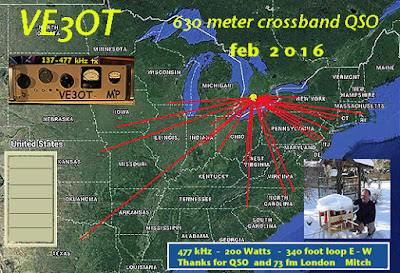 |
| VE3OT QSL and coverage from previous crossband event |
Confirmed Canadian stations include:
Station: VA7MM (Mark) CN89 Coquitlam, B.C.
Time: 0400Z – 0800Z (Saturday night Nov 13 Z)
TX Frequency: 475.0 kHz
RX (QSX) Frequency: 1801 kHz / 3574 kHz / 7062 kHz
Station: VE7BDQ (John) CN89 Delta, B.C. November 2016
Time: 0300Z – 0700Z (Saturday night Nov 13 Z)
TX Frequency: 474.0 kHz
RX (QSX) Frequency: 3555 kHz
Station: VE7CNF (Toby) CN89 Burnaby, B.C.
Time: 0300Z – 0800Z (Saturday night Nov 13 Z)
TX Frequency: 476.5 kHz
RX (QSX) Frequency: 1836 kHz / 3558 kHz / 7031 kHz
Station: VE7SL (Steve) CN88 Mayne Island, B.C.
Time: 0200Z – 0700Z (Saturday night Nov 13 Z)
TX Frequency: 473.0 kHz
RX (QSX) Frequency: 3566 / 7066 kHz
Station: VE7CA (Markus) CN89 North Vancouver, B.C.
Time: 0200Z – 0700Z (Saturday night Nov 13 Z)
TX Frequency: 477.5.0 kHz
RX (QSX) Frequency: 1820 / 3550 / 7048 kHz
Station: VO1NA (Joe) GN37 Torbay, Newfoundland
Time: 2130Z – 0130Z (Saturday night Nov 12 Z – Sunday Nov 13 Z)
TX Frequency: 477.7 kHz
RX (QSX) Frequency: 3562 kHz
Station: VE3OT (Mitch) EN92 London, ON.
Time: 0000Z – 0400Z (Saturday night Nov 13 Z)
TX Frequency: 477.0 kHz
RX (QSX) Frequency: 3563 kHz / 7058 kHz
Several US Experimental stations also will be in operation throughout the band, in two-way QSO mode with each other, using CW or JT9. Some stations will also use WSPR and QRSS CW beacon modes.
The success of this event largely depends upon the participation of as many amateurs as possible.
Hopefully you will be able to participate in the two-way cross-band activity by being able to listen on 630m and then able to switch over to HF to transmit. This could involve the use of a separate receiver / transmitter or can often be easily implemented via your transceiver's 'A/B' switch.
No antenna for receiving on 630m? Don't let that stop you from taking part in the fun. Surprisingly good results can often be had by using a low band wire antenna such as a dipole or inverted-L for listening on 630m ... the antenna does not necessarily need to be resonant. In fact, often times, a non-resonant receiving antenna can provide a better overall S/N ratio than one which is resonant, as these often gather more noise along with signals.
You may want to experiment before hand by listening to many of the numerous U.S. experimental stations operating nightly, mostly in the WSPR mode, between 475.6 and 475.8kHz. Most operators provide a CW identifier following their WSPR transmission but a better way to decode these signals is by installing the latest WSPR software, WSJT-X (freeware), at K1JT's website here. The software works extremely well and is easy to install and get working. If you set the software to 'upload spots', you can share your nightly catches with dozens of other listeners throughout the continent on the WSPRnet website.
 |
| courtesy: KB5NJD's 630m Daily Blog |
If you have further questions, please contact myself or John Langridge, KB5NJD / WG2XIQ.
 Hunting For NDBs In CLE 212
Hunting For NDBs In CLE 212
 |
| YPM-274 courtesy: ve3gop.com |
Another NDB CLE challenge is in store this coming weekend with CLE 212. This time the frequency range is 270 - 319.9 kHz bringing it into the DGPS band, although these signals should not be reported.
A good target for this range is 25W YPM in Pikangikum, Ontario, transmitting on 274 kHz. It is widely reported throughout North America, thanks to its large antenna system, pictured here. Look for it on 274.361 kHz with your receiver in 'CW' mode. Remember that most Canadian NDBs use a ~ 400Hz tone for modulation while the U.S. ones are usually ~1020Hz on both sidebands.
'CLE's' are 'Co-ordinated Listening Events', and NDB DXers around the world focus their listening time on one small slice of the NDB spectrum ... but this time around, the range has been expanded.
From CLE coordinator Brian Keyte (G3SIA), via the Yahoo ndblist Group, comes the following reminder:
Hello all
The NDB List has really come back to life recently - you can see the effect
of the good recent propagation on the number of emails we have posted
to NDB List each month since last June:
Jun Jul Aug Sep Oct (so far)
197 279 404 663 768
Our 212th co-ordinated listening event is this weekend, covering a 50 kHz
frequency range - about three times wider than usual.
Days: Friday 28 October - Monday 31 October
Times: Start and end at midday, your LOCAL time
Range: 270.0 - 319.9 kHz (NOT DGPS beacons)
We can expect very good propagation, but in part of the frequency range
it will be a bit of a challenge to tease out the NDB signals from among
the DGPS ones.
Any first-time CLE logs will be very welcome, as always.
Please log the normal NDBs you can identify that are listed in the range
(it includes 270 kHz but not 320 kHz).
Please send your CLE log to NDB List, if possible as a plain text email
and not in an attachment, with 'CLE212' at the start of its title.
Show on EVERY line of your log:
# The Date (e.g. '2016-10-28' or just '28', etc.)
# UTC (the day changes at 00:00 UTC).
# kHz - the beacon's nominal published frequency if you know it.
# The Call Ident.
Those main items can be in any order within themselves, but BEFORE any
other optional details (Location, Distance, etc.) later in the same line.
Many of us in Europe will be changing our house clocks this weekend.
UTC time continues unchanged of course, but as we finish the CLE on
Monday at LOCAL midday we may win an extra hour's listening!
As always, give details in your log of your own location and the receiver,
aerial(s), etc. that you were using.
If you send any interim logs, please also send a Final (complete) one.
You can find anything else to help you, including seeklists for your part
of the World, from the CLE page, http://www.ndblist.info/cle.htm
I will send the usual 'Any More Logs?' email at about 18:00 UTC on Tuesday so that you can check that your CLE log has been found OK. Do make sure
that your log has arrived at the very latest by 09:00 UTC next Wednesday,
2nd November. I am hoping to make all the combined results on that day.
Enjoy your listening
Brian
----------------------------------------------------------
From: Brian Keyte G3SIA ndbcle'at'gmail.com
Location: Surrey, SE England (CLE co-ordinator)
----------------------------------------------------------
(Reminder: You could use any one remote receiver for your loggings,
stating its location and owner - with their permission if required.
A remote listener may NOT also use another receiver, whether local or
remote, to obtain further loggings for the same CLE).
These listening events serve several purposes. They:
- determine, worldwide, which beacons are actually in service and on-the-air so the online database can be kept up-to-date
- determine, worldwide, which beacons are out-of-service or have gone silent since the last CLE covering this range
- will indicate the state of propagation conditions at the various participant locations
- will give you an indication of how well your LF/MF receiving system is working
- give participants a fun yet challenging activity to keep their listening skills honed
Final details can be found at the NDB List website, and worldwide results, for every participant, will be posted there a few days after the event. If you are a member of the ndblist Group, results will also be e-mailed and posted there.
The very active Yahoo ndblist Group is a great place to learn more about the 'Art of NDB DXing' or to meet other listeners in your region. There is a lot of good information available there and new members are always very welcome. As well, you can follow the results of other CLE participants from night to night as propagation is always an active topic of discussion.
If you are contemplating getting started on 630m, listening for NDBs is an excellent way to test out your receive capabilities as there are several NDBs located near this part of the spectrum.
You need not be an ndblist member to participate in the CLEs and all reports, no matter how small, are of much value to the organizers. 'First-time' logs are always VERY welcome!
Reports may be sent to the ndblist or e-mailed to either myself or CLE co- ordinator, Brian Keyte (G3SIA), whose address appears above.
Please ... give the CLE a try ... then let us know what NDB's can be heard from your location! Your report can then be added to the worldwide database to help keep it up-to-date.
 630m VK’s Light-Up North America
630m VK’s Light-Up North America
It seems that all of my blogspots of late have focused on 630m propagation ... but what has been happening down there recently has been both amazing and somewhat unexpected. With the growing number of active stations listening and transmitting, the band's propagation capabilities and mysteries are quickly revealing themselves.
Last night was a great example but perhaps the WSPRnet prop map illustrates this best.
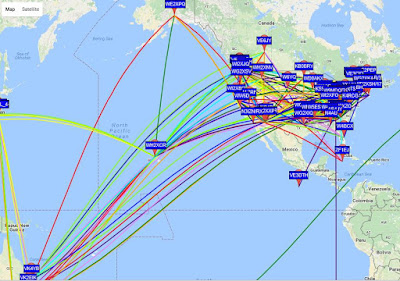 |
| courtesy: http://wsprnet.org/drupal/wsprnet/map |
Particularly striking was the long haul propagation from VK to North America, with northernmost VK4YB leading the pack. His 90 watt signal made it all the way to VE3IQB, near Ottawa as well as to NO3M, in Pennsylvania! To provide further hope to those that have little room for big receiving antennas, VE3IQB uses a typical small active e-probe antenna, 20' above ground!
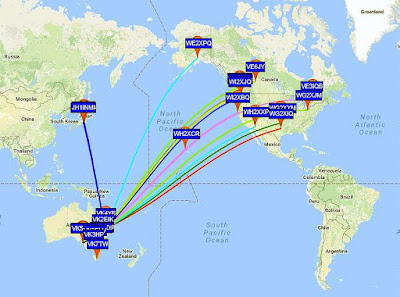 |
| courtesy: http://wsprnet.org/drupal/wsprnet/map |
 |
| courtesy: http://www.swpc.noaa.gov/ |
I'm theorizing that Roger's signal was arriving today at much lower angles than normal, evidenced by its far-reaching east coast reception and the fact that it couldn't get over my 600' local obstruction to the west. I've always believed that it takes higher angled signal arrival for me to hear Roger and today's events seem to support this.
Exactly what would cause this to be the case, I'll leave to the experts but I imagine that the sudden surge in geomagnetic activity played a significant role in today's very different propagation paths.
Roger was not the only VK lighting-up the map today. A much more detailed account of all the action can be found on the KB5NJD's daily 630m report here ... all very inspirational and hopefully enough to spur even more new activity on the MF band.
Why not give a listen and see what you can hear?

















